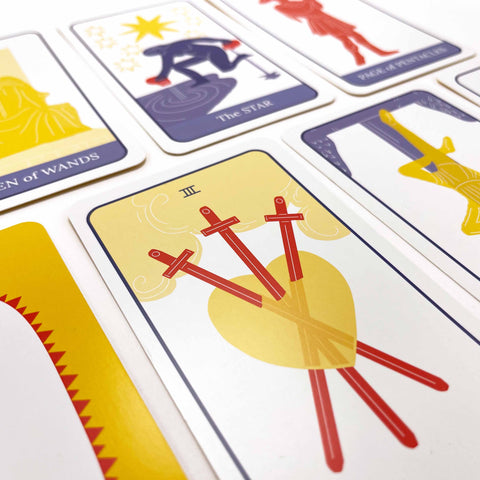Introduction to (Club) Tarot
Illustrator's note:
For many, Tarot is still a tool for their divination practice, and mate is a South American drink traditionally consumed by indigenous people. Both can carry significant cultural and spiritual meaning for many communities both in and outside Germany.
Club Tarot was originally a Christmas gift for my best friend, a love letter to her and the life we shared together (we drank a lot of soda). Creating it taught me the beautiful, rich, and layered worlds of Tarot, and it was the spark that launched Polar Embassy as a publishing house. I've learned so much from it - and will bring those learnings to the next decks Polar Embassy publishes. We will spotlight indigenous artists and artists of color who can share their sacred practices.
From this journey, I know how overwhelming the beginning can be. I hope this guide to the basics makes it fun and easy to get started. Club Tarot is meant to be an introductory deck - your first but not your last.
If you have any feedback on this deck, or if you’d like to collaborate with me to publish your own deck, I’d love to hear from you!
Have fun,
Jon

An Introduction to Tarot
First of all: what is Tarot?
Tarot can be a tool for self-reflection, with 78 cards that each show a key scene in the human experience: love, pain, transition, loss, triumph, etc. When you “read” Tarot, you pick cards at random, and interpret the advice from the story the cards make in their new combination. Reading the cards yourself, or having someone read them for you, hopefully helps you become aware of your unconscious, your “gut”. How do the cards make you feel? Does the story make sense? Does its advice apply to you? This is an active thinking exercise, not a decree. If you think the cards’ advice is exactly right or totally wrong, have you become more aware of:
- what you really think?
- what you actually want?
- what you must do now?
What makes a deck?
There are several types of Tarot. Club Tarot is based on the Rider-Waite-Smith system, in which there are four suits, the Minor Arcana, and a fifth set of cards called the Major Arcana.
Each suit begins with an Ace, the purest symbol of the suit’s sign: Wands are fire, Cups are water, Pentacles are earth, and Swords are air. From there, the suits show a rise, a fall, and a resolution through 10 cards. The suits end with four court cards: Page, Knight, King, and Queen, each radiating their own characteristics as well as the suit's.
The Major Arcana shows the odyssey of life through “The Fool’s Journey”, an epic story with higher highs and lower lows than those in the Minor Arcana. It’s a mirror of our own stories; each card shows a major plot point (or plot twist!) of life.
On Gender in the cards
Our deck Club Tarot closely follows the Rider-Waite-Smith tradition to make it easy to recognize the cards and use other guides and learning resources along with this deck. The cards are gendered, but we consider the characters they show to be non-binary, and we use gender-neutral pronouns throughout this guide.
How to start?
1) Ask the deck a question
Readings are centered with an open-ended question. The cards will never tell you if someone loves you or not, or when you will get married; the cards can instead help you find the answer to a question like “How should I approach my new creative project?” or “How should I try to rebuild trust with someone I have hurt”?
2) Shuffle
Our friend Melinda Cange shows you here how to shuffle and other helpful tips to start (in German). There are many rituals around shuffling and selecting your cards. Find one that feels right for you, or simply fan out the cards face-down and pick out the card(s) for your reading.
3) Lay a "spread"
A “one card pull” is a great way to start: randomly draw one card from the deck. How does it make you feel? Why did you get that card? What’s the deck trying to tell you?
A “spread” is two or more cards laid out in a way that structures your reading. For example, in a popular three-card spread, the cards respectively show the root of the problem, the present situation, and the solution. Some people use spreads with up to 10 cards, but here we’ll share a simple two- card spread, illustrated by a bottle on the next page.
A Club Tarot two-card spread
The first card you draw is the bottleneck: the problem, your current situation. The second card, placed below the first, is the source of the problem: the fuel behind the situation.
The ideas behind each card are complex and ambiguous, and certainly not an order. Together, they can offer you a new perspective to think about. With your cards before you, what story does the spread tell you about the problem and its source? What advice can you interpret from the deck’s point of view?

The ideas behind each card are complex and ambiguous, and certainly not definite or imperative. The up/down orientation can also offer another dimension of meaning, but this guide is a simplified starter sharing only the upright orientation. We hope this guide is helpful as you string together the story you see.
To continue learning about Tarot, our friend Melinda Cange has virtual Foundational and Advanced Tarot courses (in German) meant to help you better access your intuition, let the Tarot speak to you clearly, and more confidently interpret your spreads. She is a Tarot expert and a mindfulness powerhouse with expertises also in marketing, coaching, and yoga too! We earn affiliate commission through your order, and have a special discount for you: “clubtarot” for 10% off your course.
